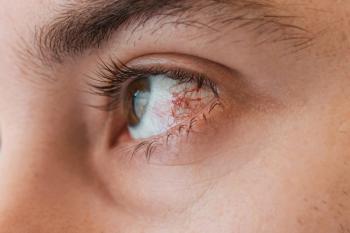
- December digital edition 2024
- Volume 16
- Issue 12
The whys and wherefores of Demodex blepharitis
Inside the role of blepharitis in ocular surface disease and effective management strategies.
Participants at a recent Optometry Times Case-Based Roundtable® discussion emphasized the importance of diagnosing and treating Demodex blepharitis as a key component of a comprehensive evaluation of patients with dry eye disease.
Christopher E. Starr, MD, FACS, shared the highlights from the discussion. Starr is an associate professor of ophthalmology, director of laser vision correction and refractive surgery service, and director of ophthalmic education at Weill Cornell Medicine, New York Presbyterian Hospital in New York.
The average age of patients undergoing cataract surgery is 73 years. Investigations have found that most of these patients have some form of ocular surface disease (OSD),1,2 including abnormal tear breakup time, abnormal corneal staining, abnormal osmolarity, and abnormal matrix metalloproteinase (MMP-9).
Recognition of the presence of OSD is important, Starr emphasized, because untreated blepharitis can increase the risk of endophthalmitis. The bacterial isolates most frequently seen in anterior blepharitis are Staphylococcus, Streptococcus, and methicillin-resistant Staphylococcus aureus.
Clinicians should not overlook Demodex mites (D folliculorum, D brevis). Endophthalmitis may not be caused by the mites, but it often is found in the presence of a high load of those common isolates, Starr said. D folliculorum clusters around the lash root and follicle, and D brevis prefers the sebaceous glands.
Demodex stats
- The prevalence of Demodex infestation increases with age, affecting more than 80% of individuals 60 years or olderand 100% of those 70 years or older.3
- Among younger patients, the Demodex blepharitis prevalence rates are consistently low, between 2% and 27%.3
- Demodex blepharitis is equally prevalent in both sexes.
- Rates of Demodex mite infestation are similar regardless of ethnicity.
The risk factors for infestation include blepharitis, rosacea, diabetes, increasing age, local or systemic immunosuppression, stress, higher alcohol intake, greater sun exposure, and smoking, Starr noted.
Demodex blepharitis treatment goals include eradicating adult mites and offspring, preventing further mating, avoiding reinfestation, and alleviating the patient’s symptoms.4
Direct damage from the mites can include epithelial hyperplasia, hair follicle duct dilatation and hyperkeratinization, reactive conjunctivitis and keratitis, eyelash loss, and meibomian gland disease (MGD). A delayed hypersensitivity response can include up-regulation of proinflammatory cytokines and the inflammatory cascade.
Representative case report
A 72-year-old woman presented for a preoperative cataract visit with red, itchy eyes and visual fluctuations with blinking. She had been diagnosed previously with allergic conjunctivitis. The clinical signs included red, itchy eyelids and lashes that were crusty and irritated when she awoke. The clinical findings were grade 3+ nuclear sclerotic cataract, best-corrected visual acuity of 20/60, irregular corneal topography, and discrepancies in the astigmatic axis and magnitude.
Starr discussed the American Society of Cataract and Refractive Surgery (ASCRS) OSD algorithm for diagnosing and managing OSD.5 For this patient, the algorithm components included the following: ASCRS SPEED II Preoperative Questionnaire with significant symptoms, osmolarity 312/331, positive inflammatory markers (MMP-9) bilaterally, significant MGD with poor expression and thick meibum, florid collarettes on the upper lid, inferior corneal punctate epithelial erosion, and telangiectasias. The algorithm pointed to delaying the cataract surgery in the presence of visually significant OSD.
Key steps in the algorithm for identifying OSD are to look at the blink, lids, lashes, and interpalpebral surface; lift the upper lid and examine the superior surface; pull the lid to assess laxity, floppy eyelids, and fornices; push the meibomian glands to assess expression; stain the cornea; and test for corneal nerve sensitivity, according to Starr.
Treatment
Potential treatments include topical antibiotics and steroids, tea tree oil, blepharoexfoliation, thermal pulsation, and immunomodulators.4 The only FDA-approved treatment specifically formulated for treatment of Demodex infestations is lotilaner ophthalmic solution, 0.25% (Tarsus Pharmaceuticals) twice daily for 6 weeks.6
Starr cited the results of an observational, extension study of patients who completed the phase 2/3 Saturn-1 study (NCT04475432).6 The results showed that compared with vehicle, significantly more patients treated with lotilaner had 0 to 2 collarettes (grade 0) or 10 or fewer collarettes (collarette grade 0 or 1) observed throughout 1 year of follow-up (21.9% vs 62.6%, respectively; P < .0001).
In this patient, treatment resulted in obliteration of the collarettes, consistent and improved refractive measurements, and regular astigmatism on topography. The ASCRS SPEED II preoperative questionnaire showed improved symptoms: normal osmolarity and MMP9; 20/50 vision without fluctuations with blinking; no crusty, itchy, or red eyelids; and resolved corneal staining. Additionally, the patient was able to undergo cataract surgery.
Christopher E. Starr, MD, FACS,
is an associate professor, director of ophthalmic education and director of the refractive surgery service and former director of the residency and cornea fellowship programs at Weill Cornell Medicine, New York-Presbyterian Hospital in New York City. He serves as a Global Ambassador to the Tear Film & Ocular Surface Society (TFOS), was a subcommittee member of the highly influential TFOS Dry Eye Workshop II (DEWS II) and currently is Chair of the Public Awareness Subcommittee of the TFOS Ocular Surface Disease (OSD) Lifestyle Epidemic Workshop and a member of the TFOS DEWS III Diagnostics Subcommittee.
References
1. Trattler WB, Majmudar PA, Donnenfeld ED,McDonald MB, Stonecipher KG, Goldberg DF; PHACO Study Group. The Prospective Health Assessment of Cataract Patients’ Ocular Surface (PHACO) study: the effect of dry eye. Clin Ophthalmol. 2017;11:1423-1430. doi:10.2147/OPTH.S120159
2. Gupta P, Drinkwater O, VanDusen KW, Brissette AR, Starr CE. Prevalence of ocular surface dysfunction in patients presenting for cataract surgery evaluation. J Cataract Refract Surg. 2018;44(9):1090-1096;doi:10.1016/j.jcrs.2018.06.026
3. Li J, Luo X, Liao Y, Liang L. Age differences in ocular demodicosis: Demodex profiles and clinical manifestations. Annals of Translational Medicine. 2021;9(9). doi:10.21037/atm-20-7715
4. Rhee MK, Yeu E, Barnett M, et al. Demodex blepharitis: a comprehensive review of the disease, current management, and emerging therapies. Eye Contact Lens. 2023;49(8):311-318. doi:10.1097/ICL.0000000000001003
5. Starr CE, Gupta PK, Farid M, et al; ASCRS Cornea Clinical Committee. An algorithm for the preoperative diagnosis and treatment of ocular surface disorders. J Cataract Refract Surg. 2019;45(5):669-684; doi:10.1016/j.jcrs.2019.03.023
6. Sadri E, Paauw JD, Ciolino JB, et al. Long-term outcomes of 6-week treatment of lotilaner ophthalmic solution, 0.25%, for Demodex blepharitis: a noninterventional extension study. Cornea. 2024;43(11):1368-1374. doi:10.1097/ICO.0000000000003484
Articles in this issue
11 months ago
A big helping of gratitude for the holidays11 months ago
Keeping it simple: Putting the patient first11 months ago
What will myopia control look like in 2034?11 months ago
The vitreous—remember me?Newsletter
Want more insights like this? Subscribe to Optometry Times and get clinical pearls and practice tips delivered straight to your inbox.



















































.png)


